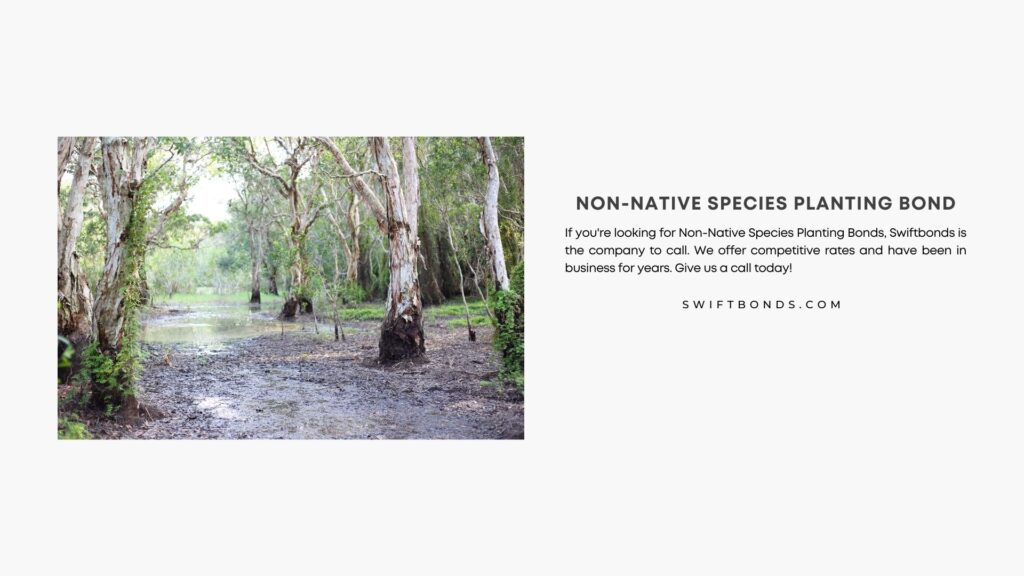
Get An Instant Quote on FL – Non-Native Species Planting Bond Now
What is FL – Non-Native Species Planting Bond?
The Florida Department of Agriculture and Consumer Services (FDACS) requires a surety bond in order to obtain the special permit required by Division of Plant Industry. This is needed because it's deemed necessary for protecting public health, safety, and welfare as well as preventing injury that would occur if an applicant refuses financial responsibility for removal or destruction costs incurred due to cultivated plants being eradicated from state-owned land upon failure.
Need a Florida Non-Native Species Planting Bond?
Swiftbonds is the perfect solution. We offer a variety of planting bonds that will help keep your land safe and beautiful. Whether you're looking for an annual, semi-annual or perennial bond, we have something for everyone!
With our bonds, there's no need to worry about costly fines or penalties if you accidentally introduce non-native plants into your area. You'll be able to enjoy the beauty of Florida without worrying about harmful pests coming in with it!
Click here now to learn more about how Swiftbonds can help protect your property today!
When do I need a non-native species planting bond?
A bond is only required when trying to cultivate any plant or group of plants that, based on experience or research data, the department determines does not pose a threat of becoming an invasive species and are commonly grown in this state for the purpose of human food consumption.
What are native and non-native plants?
Native plants are species that originate in their surrounding habitat, and have adapted to living in its particular environment. Non-native (exotic) species can be either invasive or not; invasive invasives outcompete other organisms causing damage to an ecosystem whereas harmless ones do no harm at all.
How many non-native plant species reside in the state of Florida?
Florida has been plagued by more than 500 non-native plant and animal species. Some of these animals are wreaking havoc on delicate ecosystems around the state, threatening to disrupt any natural balance that existed before they arrived.
Are non-native plants good?
Some non-native plants are invasive and damaging to native habitat but the impact of many is relatively benign. The vast majority appear to be beneficial for wildlife, such as providing food or shelter.
What are three examples of non-native species?
The Gypsy Moth, Nutria and Zebra Mussel are examples of non-native species that have caused massive economic and ecological losses in new locations. They come from different parts of the world but all pose a threat to native ecosystems because they lack natural predators or competitors.
Should you kill invasive species?
The plants that are weeded tend to be fast growing native species. So there is a movement to encourage people to grow natives on their lawns rather than imported exotic flowers and shrubs. Imported plant life can become an intrusive, out-of-place weed in the environment very easily!
What is the difference between native and non-native plants?
Native plants are wonderful because they have co-evolved with the local environment and animals to form a balanced ecosystem. But it is important not to introduce non-native species, as these do not naturally occur in this region of space time.
Why are non-native plants bad?
Non-native plants often pose a threat to the surrounding ecosystem as they are not used to its climate or animals. A plant that was harmless in one area could be poisonous elsewhere and vice versa. Need a Orange County, FL – Payment of Disposal Charges Bond.

Is it OK to plant non-native plants?
Some would argue that we should only practice native gardening, and while I completely understand why some people feel this way; just for the record: Non-native plants are often healthier and happier in our gardens. Wildlife regularly chooses these over natives
Is it bad to plant non-native trees?
It can be dangerous for your yard and the natural environment when you plant too many of those pesky plants. Chickadees won't have enough insects on which they prey, reducing their opportunity to reproduce.
Are non native plants beneficial?
Some people believe that non-native plants are harmful to the environment, while others view them as an asset. Some species of foreign plants can be highly invasive and damaging to native habitats but many also provide benefits such as food for wildlife or a habitat structure for insect life.
Is planting non-native plants bad?
If you plant non-native plants, there is a chance they will take over and cause many problems. This includes negative effects on wildlife, insects, forests and trees – not to mention the environment in general.
Why are non-native species dangerous?
Non-native species are dangerous because they harm the ecosystem. This is similar to a biological wildfire, but instead of natural fires destroying plants and animals, non-natives have destructive effects on all terrestrial and aquatic ecosystems.
What are three non-native species?
The three non-native species that have found their way to North America are Invasive Carp, Brown Marmorated Stink Bug and Zebra Mussels. Get a Okeechobee, FL – Street Opening Bond.
How can you tell if a plant is native?
Native plants are the key to maintaining an ecosystem. They provide food and shelter for wildlife, reduce erosion by stabilizing soil with their roots, filter air pollutants out of the atmosphere through photosynthesis. Native plants also have a unique ‘smell' that attracts pollinators like bees which help produce honey.
Why are non-native species a big deal?
The number one reason for species extinction worldwide is due to habitat loss. The second-leading cause of the problem, however, comes from invasive species that are destroying ecosystems and causing a great deal of harm in their wake.
Should you only plant native plants?
There are a ton of other good reasons to plant natives. For one, they require less care than many common garden plants. They also need less water and fertilizer while requiring the same amount or even more pesticide depending on what type it is!
What is the problem with non-native plants?
The problem with invasive plants is that they can displace native species and create monocultures. A healthy plant community has a variety of herbs, shrubs, and trees to keep the ecosystem in balance; but when an invasive species takes over these spaces it prevents other natives from thriving as well.
Are native plants better?
Native plants are best suited to the local climate and soil conditions where they naturally occur. They're also advantageous because: Native plants don't need fertilizers and require fewer pesticides than lawns, native plant watering needs less water than a regular garden or yard, which helps prevent erosion.
How can we prevent non-native plants?
Non-native plants can be a huge threat to our environment. If you see one, don't just ignore it – report the sighting! You will not only help native species and ecosystems thrive but also maintain biodiversity for many years to come. Have a FL – Mortgage Broker or Lender ($10,000) Bond.
What are examples of native plants?
Native plants are an important part of the ecosystem. Some examples include little bluestem, Indian grass, wild sea oats and tall prairie switchgrass. These native species provide food for wildlife as well as a natural habitat from which God's creation flourishes!
How are non native plants introduced?
Non-native plant seeds are often distributed by birds, wind or unknowing humans and allow them to move great distances. Some invasives have aggressive root systems that spread long distances from a single plant which grow densely around the roots of surrounding vegetation, smothering it in their wake.
How useful or harmful are non-native species?
Non-native species are an increasingly common feature of a globalized world and have become more problematic to manage. While not all introduced species are harmful, some exotic ones can turn invasive and cause significant damage to biodiversity, human health, or the economy.
Is it bad to plant non-native wildflowers?
Non-native plants can become invasive and take over an ecosystem. This includes negative affects on wildlife, insects, forests, trees and other local vegetation. They are considered “bad news” for the environment because they put a lot of our natural resources at risk!
How do non-native plants affect the ecosystem?
Non-native or alien species present a range of threats to native ecosystems and human well-being. Non-natives are often inadvertently demonized without sufficient awareness of the ecological principles—disturbance, niche and competition—that contribute to species dominance in an ecosystem.
Why do invasive plants outcompete native plants?
Invasive plants outcompete and displace native plants that many animals depend on for food, shelter, and more. Not only do invasive plant species take over the area of their natives counterparts but they also create a simplified habitat where non-native wildlife can live with ease as well.
What is a non-native tree?
Non-native trees are ones that have been introduced to Ireland since the end of the last Ice Age. The opposite of a native tree, these kinds of trees can be found throughout this country – in parks and gardens alike! See a Florida MOTOR VEHICLE DEALER – used – ($25,000) Bond.
What are the most dangerous and annoying invasive species?
There are countless examples of invasive plants, animals, fungi, insects etc. One example is kudzu which was introduced to help with soil erosion in the south but turned out to be a major nuisance when it spread faster than they anticipated over other vegetation. It has now grown into an unstoppable vine that suffocates everything down its path if left unchecked!
Why are non-native invasive plants so hard to get rid of?
Invasive species often spread rapidly and reproduce quickly because they have no natural predators in their new ecosystem. As a result, these invaders can threaten native plant life and disrupt important ecological processes like pollination or nutrient cycling.

